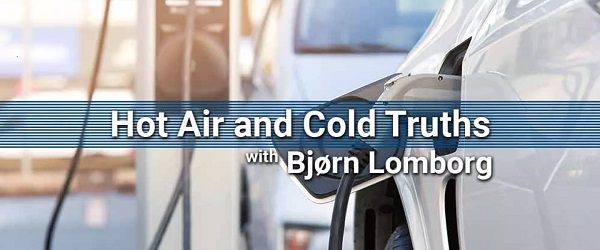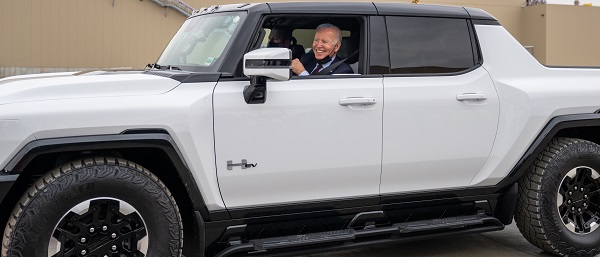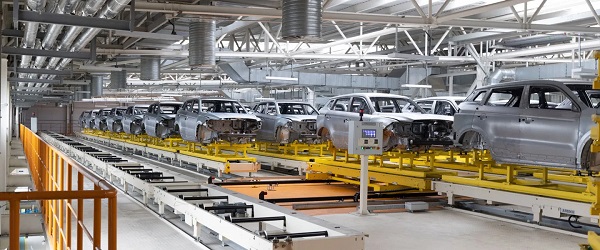Automotive
Electric cars just another poor climate policy

From the Fraser Institute
The electric car is widely seen as a symbol of a simple, clean solution to climate change. In reality, it’s inefficient, reliant on massive subsidies, and leaves behind a trail of pollution and death that is seldom acknowledged.
We are constantly reminded by climate activists and politicians that electric cars are cleaner, cheaper, and better. Canada and many other countries have promised to prohibit the sale of new gas and diesel cars within a decade. But if electric cars are really so good, why would we need to ban the alternatives?
And why has Canada needed to subsidize each electric car with a minimum $5,000 from the federal government and more from provincial governments to get them bought? Many people are not sold on the idea of an electric car because they worry about having to plan out where and when to recharge. They don’t want to wait for an uncomfortable amount of time while recharging; they don’t want to pay significantly more for the electric car and then see its used-car value decline much faster. For people not privileged to own their own house, recharging is a real challenge. Surveys show that only 15 per cent of Canadians and 11 per cent of Americans want to buy an electric car.
The main environmental selling point of an electric car is that it doesn’t pollute. It is true that its engine doesn’t produce any CO₂ while driving, but it still emits carbon in other ways. Manufacturing the car generates emissions—especially producing the battery which requires a large amount of energy, mostly achieved with coal in China. So even when an electric car is being recharged with clean power in BC, over its lifetime it will emit about one-third of an equivalent gasoline car. When recharged in Alberta, it will emit almost three-quarters.
In some parts of the world, like India, so much of the power comes from coal that electric cars end up emitting more CO₂ than gasoline cars. Across the world, on average, the International Energy Agency estimates that an electric car using the global average mix of power sources over its lifetime will emit nearly half as much CO₂ as a gasoline-driven car, saving about 22 tonnes of CO₂.
But using an electric car to cut emissions is incredibly ineffective. On America’s longest-established carbon trading system, you could buy 22 tonnes of carbon emission cuts for about $660 (US$460). Yet, Ottawa is subsidizing every electric car to the tune of $5,000 or nearly ten times as much, which increases even more if provincial subsidies are included. And since about half of those electrical vehicles would have been bought anyway, it is likely that Canada has spent nearly twenty-times too much cutting CO₂ with electric cars than it could have. To put it differently, Canada could have cut twenty-times more CO₂ for the same amount of money.
Moreover, all these estimates assume that electric cars are driven as far as gasoline cars. They are not. In the US, nine-in-ten households with an electric car actually have one, two or more non-electric cars, with most including an SUV, truck or minivan. Moreover, the electric car is usually driven less than half as much as the other vehicles, which means the CO₂ emission reduction is much smaller. Subsidized electric cars are typically a ‘second’ car for rich people to show off their environmental credentials.
Electric cars are also 320–440 kilograms heavier than equivalent gasoline cars because of their enormous batteries. This means they will wear down roads faster, and cost societies more. They will also cause more air pollution by shredding more particulates from tire and road wear along with their brakes. Now, gasoline cars also pollute through combustion, but electric cars in total pollute more, both from tire and road wear and from forcing more power stations online, often the most polluting ones. The latest meta-study shows that overall electric cars are worse on particulate air pollution. Another study found that in two-thirds of US states, electric cars cause more of the most dangerous particulate air pollution than gasoline-powered cars.
These heavy electric cars are also more dangerous when involved in accidents, because heavy cars more often kill the other party. A study in Nature shows that in total, heavier electric cars will cause so many more deaths that the toll could outweigh the total climate benefits from reduced CO₂ emissions.
Many pundits suggest electric car sales will dominate gasoline cars within a few decades, but the reality is starkly different. A 2023-estimate from the Biden Administration shows that even in 2050, more than two-thirds of all cars globally will still be powered by gas or diesel.
Source: US Energy Information Administration, reference scenario, October 2023
Fossil fuel cars, vast majority is gasoline, also some diesel, all light duty vehicles, the remaining % is mostly LPG.
Electric vehicles will only take over when innovation has made them better and cheaper for real. For now, electric cars run not mostly on electricity but on bad policy and subsidies, costing hundreds of billions of dollars, blocking consumers from choosing the cars they want, and achieving virtually nothing for climate change.
Automotive
Canada’s EV house of cards is close to collapsing

 By Dan McTeague
By Dan McTeague
Well, Canada’s electric vehicle policies are playing out exactly as I predicted. Which is to say, they’re a disaster.
Back in November, in the immediate aftermath of Donald Trump’s re-election, I wrote in these pages that, whatever else that election might mean for Canada, it would prove big trouble for the Justin Trudeau/Doug Ford EV scam.
The substance of their plot works like so: first, the federal and provincial governments threw mountains of taxpayer dollars in subsidies at automakers so that they’d come to Canada to manufacture EVs. Then Ottawa mandated that Canadians must buy those EVs — exclusively — by the year 2035. That way Ford and Trudeau could pat themselves on the back for “creating jobs,” while EV manufacturers could help themselves to the contents of our wallets twice over.
But the one variable they didn’t account for was a return of Donald Trump to the White House.
Trump had run on a promise to save America from their own back-door EV mandates. Though Kamala Harris had denied that any such mandates existed, they did, and they were founded on two acts of the Biden-Harris administration.
First, they issued an Executive Order setting significantly more onerous tailpipe regulations on all internal combustion engine (ICE) vehicles, with the explicit goal of ensuring that 50 percent of all new vehicles sold in America be electric by 2030.
Second, they granted California a waiver to make those regulations more burdensome still, so that only EVs could realistically be in compliance with them. Since no automaker would want to be locked out of the market of the most populous state, nor could they afford to build one set of cars for California (plus the handful of states which have — idiotically — chosen to align their regulations with California’s) and another set for the rest of the country, they would be forced to increase their manufacture and sale of EVs and decrease their output of ICE vehicles.
Trump’s victory took Canada’s political class completely by surprise, and it threw a spanner into the workings of the Liberals’ plan.
That’s because there just aren’t enough Canadians, or Canadian tax dollars, to make their EV scheme even kinda’ work. Canada’s unique access to the world’s biggest market — America — was a key component of the plan.
After all, vehicles are “the second largest Canadian export by value, at $51 billion in 2023, of which 93 percent was exported to the US,” according to the Canadian Vehicle Manufacturers Association, and “Auto is Ontario’s top export at 28.9 percent of all exports (2023.)”
It further depended on Americans buying more and more EVs every year. But since, when given a choice, most people prefer the cost and convenience of ICE vehicles, this would only work if Americans were pushed into buying EVs, even if in a more roundabout way than they’re being forced on Canadians.
Which is why the plan all began to unravel on January 20, the day of Trump’s inauguration, when he signed Executive Order 14154, “Unleashing American Energy,” which, among other things, rescinded Joe Biden’s pro-EV tailpipe regulations. And it has continued downhill from there.
Just last week, the US Senate voted to repeal the Biden EPA’s waiver for California. Not that that’s the end of the story — in the aftermath of the vote, California governor Gavin Newsom vowed “to fight this unconstitutional attack on California in court.” (Though don’t be surprised if that fight is brief and half-hearted — Newsom has been trying to leave his lifelong leftism behind recently and rebrand as a moderate Democrat in time for his own run at the White House in 2028. Consequently, being saved from his own EV policy might only help his career prospects going forward.)
But it’s worth noting the language used by the Alliance for Automotive Innovation, which represents car companies like Toyota, GM, Volkswagen and Stellantis (several of whom, it should be noted, have received significant subsidies from the Liberal and Ford governments to manufacture EVs), which said in a statement, “The fact is these EV sales mandates were never achievable.”
That’s worth repeating: these EV sales mandates were never achievable!
That’s true in California, and it’s true in Canada as well.
And yet, our political class has refused to accept this reality. Doug Ford actually doubled down on his commitment to heavily subsidizing the EV industry in his recent campaign, saying “I want to make it clear… a re-elected PC government will honour our commitment to invest in the sector,” no matter what Donald Trump does.
Except, as noted above, Donald Trump represents the customers Doug Ford needs!
Meanwhile, our environmentalist-in-chief, Mark Carney, has maintained the Liberal Party’s commitment to the EV mandates, arguing that EVs are essential for his vacuous plan of transforming Canada into a “clean energy superpower.” How exactly? That’s never said.
These are the words of con artists, not men who we should be trusting with the financial wellbeing of our country. Unfortunately, in our recent federal election — and the one in Ontario — this issue was barely discussed, beyond an 11th-hour attempted buzzer-beater from Pierre Poilievre and a feeble talking point from Bonnie Crombie about her concern “that the premier has put all our eggs in the EV basket.”
Meanwhile, 2035 is just around the corner.
So we can’t stop calling attention to this issue. In fact, we’re going to shout about our mindless EV subsidies and mandates from the rooftops until our fellow Canadians wake up to the predicament we’re in. It took some time, but we made them notice the carbon tax (even if the policy change we got from Carbon Tax Carney wasn’t any better.) And we can do it with electric vehicles, too.
Because we don’t have the money, either as a nation or as individuals, to prop this thing up forever.
Dan McTeague is President of Canadians for Affordable Energy.
Automotive
EV fantasy losing charge on taxpayer time

From the Fraser Institute
By Kenneth P. Green
The vision of an all-electric transportation sector, shared by policymakers from various governments in Canada, may be fading fast.
The latest failure to charge is a recent announcement by Honda, which will postpone a $15 billion electric vehicle (EV) project in Ontario for two years, citing market demand—or lack thereof. Adding insult to injury, Honda will move some of its EV production to the United States, partially in response to the Trump Tariff Wars. But any focus on tariffs is misdirection to conceal reality; failures in the electrification agenda have appeared for years, long before Trump’s tariffs.
In 2023, the Quebec government pledged $2.9 billion in financing to secure a deal with Swedish EV manufacturer NorthVolt. Ottawa committed $1.34 billion to build the plant and another $3 billion worth of incentives. So far, per the CBC, the Quebec government “ invested $270 million in the project and the provincial pension investor, the Caisse de dépôt et placement du Québec (CDPQ), has also invested $200 million.” In 2024, NorthVolt declared bankruptcy in Sweden, throwing the Canadian plans into limbo.
Last month, the same Quebec government announced it will not rescue the Lion Electric company from its fiscal woes, which became obvious in December 2024 when the company filed for creditor protection (again, long before the tariff war). According to the Financial Post, “Lion thrived during the electric vehicle boom, reaching a market capitalization of US$4.2 billion in 2021 and growing to 1,400 employees the next year. Then the market for electric vehicles went through a tough period, and it became far more difficult for manufacturers to raise capital.” The Quebec government had already lost $177 million on investments in Lion, while the federal government lost $30 million, by the time the company filed for creditor protection.
Last year, Ford Motor Co. delayed production of an electric SUV at its Oakville, Ont., plant and Umicore halted spending on a $2.8 billion battery materials plant in eastern Ontario. In April 2025, General Motors announced it will soon close the CAMI electric van assembly plant in Ontario, with plans to reopen in the fall at half capacity, to “align production schedules with current demand.” And GM temporarily laid off hundreds of workers at its Ingersoll, Ontario, plant that produces an electric delivery vehicle because it isn’t selling as well as hoped.
There are still more examples of EV fizzle—again, all pre-tariff war. Government “investments” to Stellantis and LG Energy Solution and Ford Motor Company have fallen flat and dissolved, been paused or remain in limbo. And projects for Canada’s EV supply chain remain years away from production. “Of the four multibillion-dollar battery cell manufacturing plants announced for Canada,” wrote automotive reporter Gabriel Friedman, “only one—a joint venture known as NextStar Energy Inc. between South Korea’s LG Energy Solution Ltd. and European automaker Stellantis NV—progressed into even the construction phase.”
What’s the moral of the story?
Once again, the fevered dreams of government planners who seek to pick winning technologies in a major economic sector have proven to be just that, fevered dreams. In 2025, some 125 years since consumers first had a choice of electric vehicles or internal combustion vehicles (ICE), the ICE vehicles are still winning in economically-free markets. Without massive government subsidies to EVs, in fact, there would be no contest at all. It’d be ICE by a landslide.
In the face of this reality, the new Carney government should terminate any programs that try to force EV technologies into the marketplace, and rescind plans to have all new light-duty vehicle sales be EVs by 2035. It’s just not going to happen, and planning for a fantasy is not sound government policy nor sound use of taxpayer money. Governments in Ontario, Quebec and any other province looking to spend big on EVs should also rethink their plans forthwith.
-

 Crime11 hours ago
Crime11 hours agoHow Chinese State-Linked Networks Replaced the Medellín Model with Global Logistics and Political Protection
-

 Addictions12 hours ago
Addictions12 hours agoNew RCMP program steering opioid addicted towards treatment and recovery
-

 Aristotle Foundation13 hours ago
Aristotle Foundation13 hours agoWe need an immigration policy that will serve all Canadians
-

 Business10 hours ago
Business10 hours agoNatural gas pipeline ownership spreads across 36 First Nations in B.C.
-

 Courageous Discourse8 hours ago
Courageous Discourse8 hours agoHealthcare Blockbuster – RFK Jr removes all 17 members of CDC Vaccine Advisory Panel!
-

 Health4 hours ago
Health4 hours agoRFK Jr. purges CDC vaccine panel, citing decades of ‘skewed science’
-

 Censorship Industrial Complex7 hours ago
Censorship Industrial Complex7 hours agoAlberta senator wants to revive lapsed Trudeau internet censorship bill
-

 Crime14 hours ago
Crime14 hours agoLetter Shows Biden Administration Privately Warned B.C. on Fentanyl Threat Years Before Patel’s Public Bombshells





